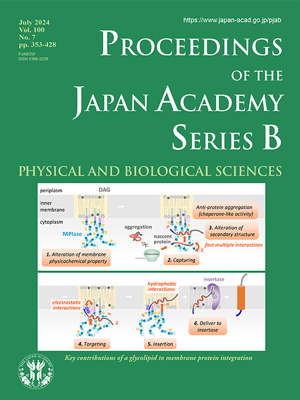About the Cover
Vol. 100 No. 7 (2024)
The integration of proteins into membranes is an important cellular event. Membrane proteins are functional only when their structures are properly positioned in membranes. To facilitate protein transport across membranes, proteins called translocons act as channels. The Sec translocon is highly conserved across species, indicating a common molecular basis for secretory protein translocation and membrane protein integration. However, translocons are functionally promiscuous, dynamically associating with various partner proteins and oligomerizing into different complexes.
While investigating roles of Sec translocons in Escherichia coli, Nishiyama et al. found that diacylglycerol (DAG), a trace component of bacterial membranes, revents disordered spontaneous membrane protein integration while an unknown factor counteracts the action of DAG and promotes integration. Subsequently, they discovered a unique factor named membrane protein integrase (MPIase) that is essential for Sec-independent membrane protein integration and stimulates both Sec-dependent integration and preprotein translocation. Thus, MPIase plays a critical role in a wide range of protein transport activities across membranes in E. coli. Despite its nomenclature implying enzymatic activity, Shimamoto et al. revealed that MPIase is a glyco-glyceropyrophospholipid. Notably, MPIase is the first glycolipid known to be involved in protein translocation, and it has a long glycan consisting of N-acetyl amino sugars, a pyrophosphate linker, and a diacylglycerol anchor. In this review (pp. 387–413), Shimamoto and co-workers have investigated the contribution of these structural features to its integration-promoting ability using a combination of synthetic chemistry and biophysical analyses. They elucidate the opposing impacts of MPIase and DAG on membrane properties and discuss how these lipids regulate membrane protein integration in bacterial membranes.
The cover schematic illustrates the mechanism of action of MPIase: DAG impedes membrane mobility, hindering substrate protein contact, whereas MPIase restores mobility and facilitates integration. It captures proteins with its long glycans, preventing aggregation, and aids in their insertion into the membrane. Proteins undergo structural changes to prevent aggregation and are attracted to the membrane surface by the negative charges on MPIase, facilitating their insertion into the membrane. Finally, proteins are delivered to other factors for complete integration if necessary.
Despite being non-proteinaceous, MPIase functions like a chaperone, preventing protein aggregation and transporting proteins to the membrane surface. These findings provide profound insights into the novel biological functions of glycolipids and their crucial role in regulating membrane protein integration in bacterial membranes.
Shigetada Nakanishi
Member of the Japan Academy




